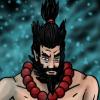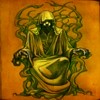on Ulfsarks ...Gotta dispute you on that
You are most welcome ...
... very good with some substantial debate, I think both Ulfsarks and Berserkers need some more explanation - I'll be away on some business for a few days, so for now just this:... and thanks for your keen interest in my ancestors
- Don't trust Wikipedia etc. too much - there are some 'Viking Romanticism' on some of those sites (IMO the above picture looks like that). Usually you get the best information on 'Viking reenactment' sites (I'll post a list in the research topic soon) or from scientific research (not easy accessibly as most are in scandinavian languages)
- Odin himself did not have some chosen warrior-class, he did only support some of the strongest and legendary heroes (and those we know by their proper name) and he could sometimes be treacherous even to those, minding only his own designs. However all Viking warriors did worship Odin as the God of battle.
You are quite welcome.
I found some info on ulfsark from a scource which refers to scholarly works and norse poems.
Here is the link Ulfsark
Here is some info from it about ulfsark
The etymology of the term berserk is disputed. It may mean "bare-sark," as in "bare of shirt" and refer to the berserker's habit of going unarmored into battle. Ynglingasaga records this tradition, saying of the warriors of Óðinn that "they went without coats of mail, and acted like mad dogs and wolves" (Snorri Sturluson. Heimskringla: History of the Kings of Norway. trans. Lee M. Hollander. Austin: Univ.of Texas Press. 1964. p.10). Others have contended that the term should be read "bear-sark," and describes the animal-skin garb of ther berserker. Grettirs Saga calls King Harald's berserkers "Wolf-Skins," and in King Harald's Saga they are called ulfhedinn or "wolf-coats," a term which appears in Vatnsdæla Saga and Hrafnsmál (Hilda R. Ellis-Davidson,"Shape-Changing in the Old Norse Sagas," in Animals in Folklore. eds. J.R. Porter and W.M.S. Russell. Totowa NJ: Rowman and Littlefield. 1978. pp. 132-133), as well as in Grettirs Saga (Denton Fox and Hermann Palsson, trans. Grettir's Saga." Toronto: Univ.of Toronto Press. 1961. p. 3).
The berserker is closely associated in many respects with the god Óðinn. Adam of Bremen in describing the Allfather says, "Wodan --- id est furor" or "Wodan --- that means fury." The name Óðinn derives from the Old Norse odur or óðr. This is related to the German wut, "rage, fury," and to the Gothic wods, "possessed" (Georges Dumezil. The Destiny of the Warrior. Chicago, Univ. of Chicago Press. 1969. p. 36). This certainly brings to mind the madness associated with the berserker, and other Óðinnic qualities are seen to be possessed by the berserk. Ynglingasaga recounts that Óðinn could shape-shift into the form of a bird, fish, or wild animal (Snorri Sturluson, p. 10).
The berserker, too, was often said to change into bestial form, or at least to assume the ferocious qualities of the wolf or bear. Kveldulfr in Egils Saga Skallagrímsonar was spoken of as a shapechanger (Hermann Palsson and Paul Edwards, trans. Egil's Saga. NY: Penguin. 1976. p. 21), and Hrolf's Saga tells of the hero Bjarki, who takes on the shape of a bear in battle:
Men saw that a great bear went before King Hrolf's men, keeping always near the king. He slew more men with his forepaws than any five of the king's champions. Blades and weapons glanced off him, and he brought down both men and horses in King Hjorvard's forces, and everything which came in his path he crushed to death with his teeth, so that panic and terror swept through King Hjorvard's army..." (Gwyn Jones. Eirik the Red and Other Icelandic Sagas. NY: Oxford Univ. Press. 1961. p. 313).
Dumezil refers to this phenomenon as the hamingja ("spirit" or "soul") or fylgja ("spirit form") of the berserker, which may appear in animal form in dreams or in visions, as well as in reality (Georges Dumezil. Gods of the Ancient Northmen. Los Angeles: Univ.of California Press. 1973. p. 142).
The berserk was sometimes inherently possessed of this immunity, or performed spells to induce it, or even had special powers to blunt weapons by his gaze. Many tales say of their berserkers, "no weapon could bite them" or "iron could not bite into him." This immunity to weapons may also have been connected with the animal-skin garments worn by the berserk. As we saw above, while in animal form, "blades and weapons glanced off" Bodvar Bjarki. Similarly, Vatnsdæla Saga says that "those berserks who were called ulfhednar had wolf shirts for mail-coats" (Ellis-Davidson, "Shape Changing," p. 133). This concept of immunity may have evolved from the berserker's rage, during which the berserk might receive wounds, but due to his state of frenzy take no note of them until the madness passed from him. A warrior who continued fighting while bearing mortal wounds would surely have been a terrifying opponent.
It is likely that the berserk was actually a member of the cult of Óðinn. The practices of such a cult would have been a secret of the group's initiates, although the Byzantine emperor Constantine VII refers in his Book of Ceremonies to a "Gothic Dance" performed by members of his Varangian guard, who took part wearing animal skins and masks: this may have been connected with berserker rites (Hilda R. Ellis-Davidson. Pagan Scandinavia. NY: Frederick A. Praeger. 1967. p. 100).
Some images of ulfsark and berserker:


























